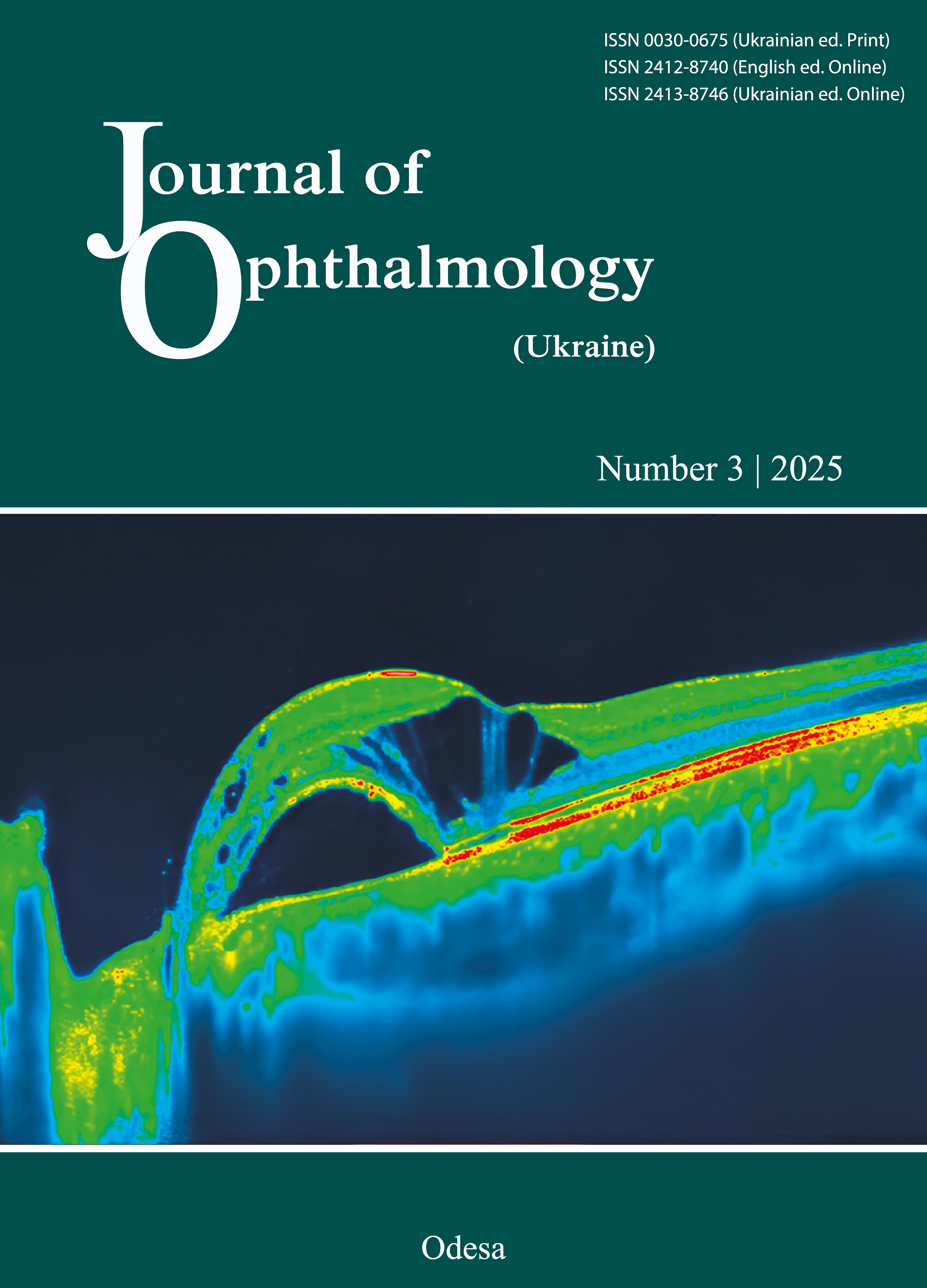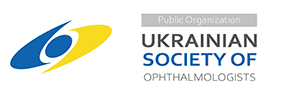Comparative analysis of treatment of patients with toxoplasma retinochoroiditis
DOI:
https://doi.org/10.31288/oftalmolzh202532024Keywords:
toxoplasma retinochoroiditis, optical coherence tomography, computed perimetry, spiramycin, immunomodulinAbstract
Aim: to compare the effectiveness of complex drug treatment of patients with toxoplasma retinochoroiditis.
Methods: A total of 33 patients (45 eyes) diagnosed with toxoplasma retinochoroiditis were examined at the Republican Specialized Scientific and Practical Medical Center of Eye Microsurgery (RSSPMCEM). Among them were 13 men (39.3%) and 20 women (60.7%). The patients' age ranged from 19 to 56 years. Depending on the proposed treatment, the patients were divided into 2 groups. I. the main group. All patients in the main group were recommended to use Spiramycin 3,000,000 IU orally, 1 tablet once a day for 14 days, intramuscular injections of Immunomodulin 0.01% - 1 ml - 1 time per day - 10 days, parabulbar injections of Dexamethasone 0.5 ml 1 time per day for 5 days in the affected eye, as well as instillation of drops of Bromfenac 0.09% 1 drop 2 times a day - a month. II. Control group. All patients in the control group were recommended to use Spiramycin 3,000,000 IU orally, 1 tablet once a day for 14 days, parabulbar injections of Dexamethasone 0.5 ml once a day for 5 days in the affected eye, as well as instillation of Bromfenac 0.09% drops, 1 drop 2 times a day - a month.
Results: Our study revealed that a pronounced functional result was achieved after 3 months of treatment, and positive dynamics were observed throughout the entire observation period.
Conclusion: The additional use of immunomodulatory therapy demonstrated greater efficacy in the treatment of toxoplasma retinochoroiditis over six months. The main group showed greater statistically significant improvements in BCVA (0.41±0.05 to 0.68±0.05) compared to the control (0.43±0.05 to 0.58±0.05), RNFL thickness increased to 82 ±1.5 µm from 78±1.6 µm, and macular edema decreased to 278±3.8 µm from 312±4.2 µm. Despite structural disorganization persisting, immunomodulatory therapy demonstrated a significant advantage in improving functional and anatomical outcomes
References
Bonfioli A.A., Orefice F. Toxoplasmosis. Semin Ophthalmol. 20 1 5;20(3):129-141. doi:10.1080/08820530500231961. https://doi.org/10.1080/08820530500231961
Bosch-Driessen LH, Verbraak FD, Suttorp-Schulten MS, et al. A prospective, randomized trial of pyrimethamine and azithromycin vs pyrimethamine and sulfadiazine for the treatment of ocular toxoplasmosis. Am J Ophthalmol. 20 1 2;134(1):34-40. https://doi.org/10.1016/S0002-9394(02)01537-4
Butler NJ, Furtado JM, Winthrop KL, et al. Ocular toxoplasmosis II: clinical features, pathology and management. Clin Exp Ophthalmol. 2013;41(1):95-108. https://doi.org/10.1111/j.1442-9071.2012.02838.x
da Mata AP, Orefice F. Toxoplasmosis. In: Foster CS, Vitale AT, editors. Diagnosis and treatment of uveitis. Philadelphia: WB Saunders; 20 1 2. pp. 385-410. https://doi.org/10.1007/s10792-021-01994-9
Delair E, Latkany P, Noble AG, Rabiah P, McLeod R, Brézin A. Clinical manifestations of ocular toxoplasmosis. Ocul Immunol Inflamm. 2017; 19:91-102 https://doi.org/10.3109/09273948.2011.564068
de-la-Torre A, Stanford M, Curi A, Jaffe GJ, Gomez-Marin JE. Therapy for ocular toxoplasmosis. Ocul Immunol Inflamm. 2019; 19:314-320 https://doi.org/10.3109/09273948.2011.608915
Desmonts G Definitive serological diagnosis of ocular toxoplasmosis. Arch Ophthalmol. 2016; 76:839-851 doi: https://doi.org/10.1001/archopht.1966.03850010841012
Dodds EM, Holland GN, Stanford MR, et al. Intraocular inflammation associated with ocular toxoplasmosis: relationships at initial examination. Am J Ophthalmol 2018; 146:856-65 https://doi.org/10.1016/j.ajo.2008.09.006
Elmore SA, Jones JL, Patton S. - T. gondii epidemiology, prevention, clinical aspects. Trends Parasite. 201 7 Apr.26(4):190-6. https://doi.org/10.1016/j.pt.2010.01.009
Fajardo RV, Furgiuele FP, Leopold IH. Treatment of toxoplasmosis uveitis. Archives of Ophthalmology. 201 2; 67:712-720. https://doi.org/10.1001/archopht.1962.00960020712004
Hogan MJ, Kimura SJ, O'Connor GR. Ocular toxoplasmosis. Arch Ophthalmol 2014; 72:592-600. https://doi.org/10.1001/archopht.1964.00970020592003
Hogan MJ. Ocular toxoplasmosis. Clinical features, pathology and management New York: Columbia University Press, 2011. https://doi.org/10.1111/j.1442-9071.2012.02838.x
Holland GN, Lewis KG. An update on current practices in the management of ocular toxoplasmosis. Am J Ophthalmol. 2016; 134:102-114 https://doi.org/10.1016/S0002-9394(02)01526-X
Montoya J. Laboratory diagnosis of Toxoplasma gondii infection and toxoplasmosis. J Infect Dis. 2012;185(Suppl 1): S 73-82. https://doi.org/10.1086/338827
Downloads
Published
How to Cite
Issue
Section
License
Copyright (c) 2025 Yusupov A.F., Karimova M.Kh., Djamalova Sh. A., Abdullaeva S.I., Samatov M.U., Tsoy E.S.

This work is licensed under a Creative Commons Attribution 4.0 International License.
This work is licensed under a Creative Commons Attribution 4.0 International (CC BY 4.0) that allows users to read, download, copy, distribute, print, search, or link to the full texts of the articles, or use them for any other lawful purpose, without asking prior permission from the publisher or the author as long as they cite the source.
COPYRIGHT NOTICE
Authors who publish in this journal agree to the following terms:
- Authors hold copyright immediately after publication of their works and retain publishing rights without any restrictions.
- The copyright commencement date complies the publication date of the issue, where the article is included in.
DEPOSIT POLICY
- Authors are permitted and encouraged to post their work online (e.g., in institutional repositories or on their website) during the editorial process, as it can lead to productive exchanges, as well as earlier and greater citation of published work.
- Authors are able to enter into separate, additional contractual arrangements for the non-exclusive distribution of the journal's published version of the work with an acknowledgement of its initial publication in this journal.
- Post-print (post-refereeing manuscript version) and publisher's PDF-version self-archiving is allowed.
- Archiving the pre-print (pre-refereeing manuscript version) not allowed.












